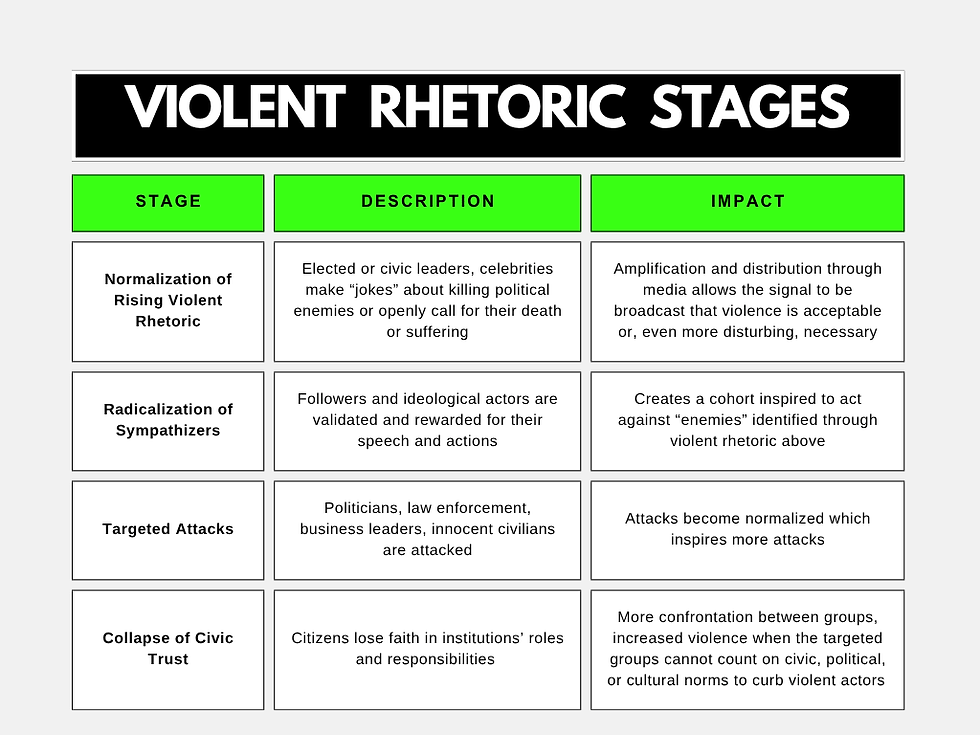Violent Rhetoric is a Public Safety Threat: What Leaders Must Do Now
- Brad Parker

- Nov 7
- 3 min read
A viral video in which a speaker openly calls for killing political opponents is not rhetorical theater — it is concrete evidence that violent rhetoric is accelerating

A recently circulated video shows an individual explicitly declaring violence against people based on political affiliation. The statement:
"I am officially declaring war on the Republican Party. If you are a Republican on TikTok and you want to interact with me, you deserve to die. You deserve to be shot. You deserve whatever suffering could possibly come to you. If you are a Republican and try to start any of that kind of nonsense with me in person, you will lose your life. This is war. I am not joking. It's done. You are not an American anymore. You're out. — We're gonna start giving you the cold, in the form of massive stones on top of a slab of wood on top of you.”
This not hyperbole or heated talk; it is a public threat that removes fundamental barriers to violence and signals a willingness to act.
This example is one among many signs we are seeing across social platforms and public venues: threats and calls to violence moving from private rhetoric to public posts, and from posts to actions.
We’ve previously documented the rise of what is now have called an “assassination culture” and highlighted how this trend creates new protection needs for individuals and institutions.
Why this matters — the dynamics at work
Violent rhetoric is not merely offensive speech — it plays an active role in shaping behavior and risk by:
Legitimizing violence: Repeated public threats erode social norms that once made political violence unthinkable.
Desensitizing audiences: Graphic threats and calls to harm reduce the psychological barrier to committing violence.
Inciting imitators: Public calls for violence serve as scripts and permission structures for impressionable or radicalized actors.
Targeting identity groups: When threats single out groups (by politics, religion, race, etc.), they create predictable, repeatable targeting patterns that are easier to operationalize.
Undermining community safety: Schools, public meetings, and local institutions become higher-risk environments; ordinary civic participation becomes dangerous for some citizens.
Below is a concise framework that shows how violent rhetoric translates into an unsafe culture.
How violent rhetoric creates an unsafe culture

Evidence we already have
We are seeing real-world consequences: threats against school boards, attacks on civic leaders, and targeted violence against executives. Earlier this year we highlighted the security implications following the assassination of a corporate CEO — a stark example of how elevated threats require elevated protection. (Links to prior coverage and analysis: [Emerging threats: normalized political violence], [Urgent need: enhanced executive protection], and [From school boards to street violence].)
Practical recommendations — what organizations and leaders must do now
This is not a problem that will be solved by rhetoric alone. Leaders must adopt a layered, practical approach:
For corporate leaders & high-net-worth individuals
Conduct a threat review: identify credible threats, at-risk employees, and exposure points (social media, events, public commentary).
Implement layered security: access controls, vetted vehicle plans, randomized movement, and executive protection for credible threats.
Strengthen incident response: prepare evacuation plans, notification trees, and legal counsel on doxxing and threats.
For schools, local boards, and civic institutions
Treat threats seriously: escalate violent rhetoric to local law enforcement and document incidents.
Harden public meetings: controlled access, identity checks, remote attendance options, and trained security or marshal presence.
Train staff: de-escalation, threat recognition, and what to do when confronted by violent rhetoric or stalking.
For security teams & providers
Monitor open-source threats: social platforms and local forums can provide early indicators.
Prioritize protective intelligence: verify threats and assess the actor’s intent, means, and opportunity.
Coordinate with law enforcement: ensure legal evidence collection and response planning.
For platforms & community leaders
Enforce policies consistently: remove direct threats and ramp up account enforcement for repeat offenders.
Increase transparency: report aggregated takedown statistics and cooperating jurisdictions.
Support reporting pathways: make it easy for users to report threats and get timely responses.
Policy and societal actions
Support stronger enforcement of laws that criminalize credible threats.
Invest in public education about online radicalization and the real-world consequences of violent rhetoric.
Promote civic norms that re-stigmatize political violence and protect free speech that doesn’t threaten life or safety.
A Wake-UP Call
Words can be weapons. When a public message openly instructs or celebrates violence, it creates real, measurable danger. Leaders in government, business, education, and platform governance must act with urgency. Individuals and institutions should treat violent rhetoric as a security risk — not an abstract moral debate — and take concrete steps to protect people and preserve civic life.
If you’re responsible for an organization, school board, executive office, or community forum and want practical next steps, reach out for help with risk assessments, emergency planning, and protective strategies consistent with your exposure.



Comments